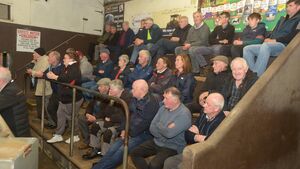Farmers are now facing many challenges

Some of the large attendance at a meeting organised by the Mayo branch of the Irish Farmers Association (IFA) at Balla Mart last month in conjunction with Aurivo Co-operative Society. Picture: Frank Dolan
It’s a tough time to be a farmer in Ireland.
Maybe it always was but this year’s exceptional rainfall sees farmers feeding silage to cattle indoors in August – after doing so in the springtime too when the animals should be out grazing the land. Fields are so wet that cattle cannot be allowed out onto them in many parts.
If this wasn’t enough of a challenge, the industry saw the Nature Restoration Law implemented almost immediately after the European Elections in June. The law has many far-reaching consequences for Irish farmers. The law was passed in the EU and it sets out targets and ambitions, which the Irish government has to devise a means to achieve.
Under the European Green Deal, the EU Biodiversity Strategy for 2030 sets out the general objective of reversing biodiversity loss, so that Europe's biodiversity is on the path to recovery by 2030, and that by 2050 all of the EU’s ecosystems are restored, resilient and adequately protected. This is a noble ambition. But what does it mean?
Amongst the ecosystems to be restored under the law, the natural connectivity of rivers and functions of floodplains, pollinator populations, agricultural ecosystems (including drained peatlands) and forest ecosystems will be of most interest to farmers.
The law sets out the restoration ambitions and deals with wetlands, forests, grasslands, rivers and lakes, heath, scrub, rocky habitats and dunes. It seeks to establish where these habitats are located and establish their existing condition. Governments then must put measures in place to bring at least 30% of habitats that are not in good condition up to good condition by 2030, and to bring back species populations by improving and enlarging their habitats.
The law also deals with the restoration of natural connectivity of rivers and natural functions of related floodplains and aims to remove artificial barriers that prevent the connectivity of surface waters, put measures in place to improve the natural function of related floodplains and contribute towards an EU ambition of at least 25,000 km of rivers to be restored to a free-flowing state by 2030.
The law further aims to put measures in place to reverse the decline of pollinator populations by 2030 to achieve an increasing trend in grassland butterflies and farmland birds. Of particular interest to farmers is the plan to reverse the decline in the stock of organic carbon in cropland mineral soils, and the share of agricultural land with high-diversity landscape features.
The law will put measures in place to restore drained peatlands under agricultural use at the rate of 30% by 2030, of which at least a quarter shall be rewetted, 40% by 2040, of which at least a third shall rewetted, and 50% by 2050, of which at least a third shall be rewetted. Rewetting peatland means the process of changing a drained peat soil towards a wet soil.
In the short term, this rewetting can be achieved on state lands like disused Bord na Móna lands. It is ironic to be discussing rewetting land when you look out the window or walk the fields in their current state.
The Irish government must produce a draft National Restoration Plan within 24 months of regulation coming into force. What happens beyond that is likely to require significant changes in existing farming practices.
The plan must specify how targets are to be delivered and will cover the period until 2050. The plan needs to quantify and map areas to be restored, describe restoration measures in place and how targets will be reached, and outline timescales and monitoring requirements.
Farmers are likely to be offered some financial incentive to adopt the necessary changes. As of yet, what precise changes are necessary is unclear, with the National Parks and Wildlife Service – the organisation that manages the Irish State's nature conservation responsibilities – tasked with producing Ireland’s National Restoration.
Another potential assault on the farming industry comes from China.
Irish farmers are poised to bear the brunt of a looming trade conflict between the European Union and China, as Chinese authorities have launched an anti-subsidy investigation into imported dairy products from the EU. This development appears to be a retaliatory move by China in response to the EU's recent decision to impose tariffs on electric vehicles imported from China.
The potential impact on the Irish dairy industry could be severe, as any restrictions on EU dairy exports would primarily affect Ireland. China has become an important market for Irish dairy, particularly in supplying the country’s vast baby formula sector.
The investigation, launched by China's commerce ministry last week, will scrutinise various dairy products, including cheeses, milk, and creams intended for human consumption.
In 2022, Irish agri-food exports to China were valued at €722 million, with dairy sales alone accounting for approximately €400 million. Of the EU countries under investigation, Ireland is by far the largest exporter of dairy to China, making the Irish dairy sector particularly vulnerable to any new restrictions.
China's decision follows the EU's announcement of reduced but still significant duties on imports of Chinese-made electric vehicles - a move Beijing had urged Brussels to reconsider. As the situation escalates, Irish farmers face increasing uncertainty about the future of their exports to China, a key market for their products.
In better news, the Government has revealed a comprehensive plan aimed at retaining Ireland's Nitrates Derogation, addressing water quality concerns that have become increasingly pressing. Agriculture Minister Charlie McConalogue's proposal includes key changes, most notably the introduction of a planning exception for slurry storage facilities in response to widespread objections to these developments across the country.
Under the new regulations, a distinct exempted development threshold will be introduced specifically for standalone manure storage facilities. This measure, which will follow the enactment of updated planning regulations, is intended to simplify the approval process for farmers who need to expand or improve their slurry storage. This expansion is crucial for managing nutrient run-off and safeguarding water quality.
In addition to the planning changes, the Government will seek approval from the European Commission to amend both the Rural Development Plan and the CAP Strategic Plan. A significant part of the proposed amendments is the introduction of a 60% grant rate and a dedicated €90,000 ceiling for nutrient storage investments, effective from January 2025. Eligible investments under this scheme will include mass concrete tanks, precast tanks, geomembrane-lined stores, circular slurry stores, and manure pits.
The proposal also calls for a detailed environmental and economic assessment of the potential consequences of losing the Nitrates Derogation, scheduled for 2025. This assessment will examine the impact of possible reductions in the maximum chemical nitrogen allowances for grassland stocking rates and key arable crops. The findings will be crucial for the review of the Nitrates Action Programme for the 2026–2029 period.
The Government's plan also includes previously announced measures, such as the employment of water quality advisors, the €60 million Farming for Life Programme, and grant aid for storage on farms importing slurry.
The Government has opted to delay the introduction of the Residential Zoned Land Tax by a year and intends to create a new scheme that will exempt farmers. Finance Minister Jack Chambers' decision is good news for farmers, who were concerned that their working land would be heavily taxed under the original plan.
The proposed tax aimed to levy a 3% charge on land zoned for residential development based on its market value. The goal was to encourage the release of more land for housing construction and discourage speculators from holding onto serviced sites.
Originally announced in the 2022 Budget, the tax was scheduled to take effect in February 2025 with payments due by May. However, it faced strong opposition from farmers whose land, which was zoned for residential use, was actually being utilised for agriculture.
Following extensive discussions with Housing Minister Darragh O’Brien and Agriculture Minister Charlie McConalogue, Minister Chambers decided to delay the tax implementation for another 12 months.






